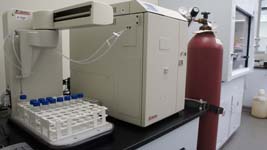Low-level Mercury Analysis
Biogeochemical Analytical Service Laboratory has the capability to provide low-level mercury (Hg) analysis, including total Hg (THg), methyl Hg (MeHg), as well as spiked stable Hg isotope analysis, in all forms of matrices.
Biogeochemical Analytical Service Laboratory currently houses the following instruments for low-level mercury analysis:
Tekran 2600 Automated Total Mercury Analyzer
Tekran 2700 Methyl Mercury Analyzer
Tekran 2750 Methyl Mercury Distillation System
Milestone DMA-80 Direct Mercury Analyzer
Labconco Freezone 12
Elan DRC-e ICP-MS
Agilent 7900 ICP-MS
UV digestor
Methodologies for mercury analysis:
Total Mercury by Cold Vapor Atomic Fluorescence Spectrometry (CVAFS)
Bromine Monochloride (BrCl) is added to the sample container to oxidize all forms of Hg to HgII oxidation state. After a minimum of 12 hours the BrCl is neutralized by addition of Hydroxylamine Hydrochloride (NH2OH*HCl). Following neutralization, Stannous Chloride (SnCl2) is added to the sample to reduce the Hg from the HgII to the Hg0 oxidation state. The Hg0 is purged onto gold-coated glass bead traps (sample). The mercury vapor is thermally desorbed to a second gold trap (analytical) and from that detected by cold vapor atomic fluorescence spectrometry (CVAFS). Samples high in organic matter may require initial pretreatment in an ultra violet (UV) digester to remove the color associated with the organic matter.
Matrices: Water
Detection Limits:
Total Mercury (THg) in Water RDL: 0.06 ng/L
Dissolved Mercury (DHg) in Water RDL: 0.08 ng/L
Total Mercury by Direct Mercury Analyzer DMA-80
Solid samples are dried and then thermally and chemically decomposed in an oxygenated decomposition furnace to liberate the mercury from the samples. The decomposition products are carried via oxygen to the catalytic tube where the mercury is reduced to Hg0 and then trapped on the amalgamator. Any remaining products and interferences are flushed with oxygen gas, then the amalgamator is rapidly heated to release the mercury vapor into the absorbance cells. The mercury is then measured using atomic absorption spectrophotometry.
Matrices: Solid
Detection Limits:
Total Mercury (THg) in Sediment RDL: 0.006 ng
Methyl Mercury by 2700 Methyl Mercury Analyzer coupled to Agilent 7900 ICP Mass Spectrometer
Distillation:
Water samples are spiked with the known amount of enriched methylmercury isotope (201MeHg) as an internal standard. The spiked samples are distilled at 127 °C by Tekran 2750 Methyl Mercury Distillation System with the addition of ammonium 1-pyrrolidinecarbodithioate (APDC) and hydrochloric acid (HCl) to remove matrices that may interfere with the ethylation process.
Solid samples are spiked with the known amount of enriched methylmercury isotope (201MeHg) as an internal standard. The spiked samples are distilled at 147 °C by Tekran 2750 Methyl Mercury Distillation System with the addition of Sulfuric Acid (H2S04) and Potassium Chloride (KCl) to remove matrices that may interfere with the ethylation process.Analysis:
Ascorbic acid is added to distillate to remove any trace of free chlorine. In a glass vial, the distillate is adjusted to pH 4.9 with acetate buffer. Sodium tetraethyl borate (NaTEB) is added to distillate for ethylation of MeHg to volatile MeHgEt. The ethylated samples are loaded on to the Tekran 2700 Methyl Mercury Analyzer coupled with Agilent 7900 ICP-Mass Spectrometer (ICP-MS) (Water)/ Elan DRC-e ICP-Mass Spectrometer (ICP-MS) (Solid). On the Tekran 2700 Methyl Mercury Analyzer, volatile ethylated mercury compounds in the sample are stripped from the liquid phase with argon gas,trapped and desorbed on the Tenax trap, separated mercury species by capillary GC and temperature ramping GC oven, then pyrolytic break down of mercury compounds to Hg (0). The elemental mercury is then introduced to ICP-MS to detect for mercury isotope 202 and 201. The concentrations are measured based on the ratio of mercury isotope with the correction of internal standard.
Matrices: Water, particulates (on filters), biological Tissue (Fish, invertebrates), plants, soils, sediments
Detection Limits:
Methyl Mercury (MeHg) in Water RDL: 0.01 ng/L
Dissolved Methyl Mercury (DMeHg) in Water RDL: 0.01 ng/L
Methyl Mercury (MeHg) in solid (eg. Tissue, plant, soil) RDL: 5 pg/g
*RDL: Reportable Detection Limits
If you are interested in any of the above analyzes, please contact Dr. Mingsheng Ma (mingsheng.ma@ualberta.ca) for more information.

